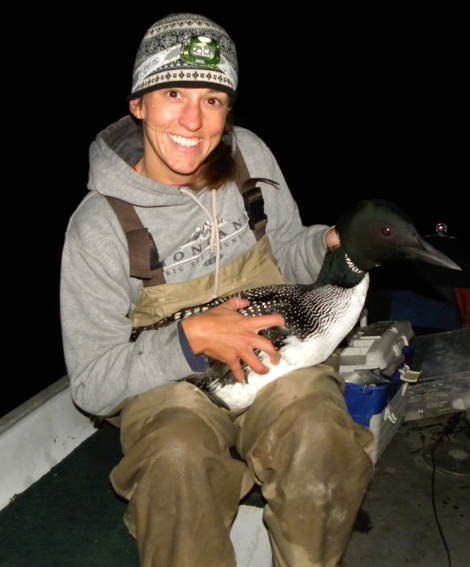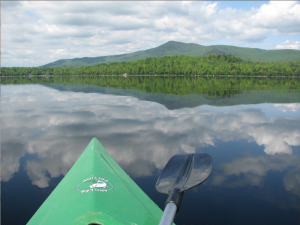Research Highlights: Tracking Changes in Maine Loon Populations
By Allison Byrd, Graduate Student at the University of Maine Orono
As the climate changes, many bird species may face shifting and restricted ranges. The birds of the boreal ecosystem, like the common loon (Gavia immer), may be particularly at risk. Over the next century, expected changes to freshwater boreal ecosystems include increased amount and variability of precipitation, increased lake level fluctuation, earlier spring run-off, and extended drought periods. We are currently investigating the vulnerability of New England’s loons to these changes and plan to use this information to suggest current and future management actions. Effective and appropriately prioritized loon conservation actions in an era of changing climate require accurate, predictive models of the mechanisms behind their range contraction and expansion.
Current models for the boreal bird community predict that large portions of the United States, including Maine, will no longer contain suitable breeding habitat for the common loon in the next 100 years. These models, however, are likely misleading because they are based on expected changes in vegetation. While forest composition and tree assemblages may be important for many songbirds, they are not of high ecological importance for loons, which spend the entire breeding season on the surface of lakes and reservoirs.

Our research combines:
- demographic analysis
- physiological measures
- behavioral observations across a range of climatic conditions to predict how future lake alterations may impact loon distributions
We are compiling information from 25 years of breeding season data gathered by the Biodiversity Research Institute and will pair this information with long-term data on relevant habitat features, such as lake acidity, water clarity, and surface temperature, gathered by University of Maine researchers and other agencies across New England. These models will allow us to predict the conditions that would cause loon productivity in New England to decline, and the conditions at which productivity would cease.
We are also evaluating the energetic costs of breeding on lakes across a gradient of conditions predicted to change. Energetic assessment is a relatively sensitive method for examining the likelihood of loon persistence on a given lake with specific attributes since birds in poor conditions are less faithful to a given territory. We collect blood samples to measure fat reserves and record behavioral observations, in collaboration with regional biologists, to study the frequency of energetically costly behaviors. Both of these approaches will create a framework for evaluating the environmental characteristics that provide the least and most valuable breeding locations in the study area.
During the 2010 field season, we collected blood samples to test if loons were acquiring fat, using their fat reserves, or if their reserves were unchanging. From these samples, we have established baseline fat levels for loons. We will be able to compare these results to subsequent years and to other geographic locations along the periphery of current loon distribution to test for changes in the energetic cost of breeding.

Preliminary results point to a decrease in glycerol levels as the breeding season progresses, which suggests a possible decrease in fat burning as chicks age, but further analyses will help clarify this finding. There is no difference in glycerol measures between loons raising one chick versus raising two. With further analysis, we will use these values to determine how loons will cope with the increased energy demands and decreased resource availability that may accompany climate change.
We have also recruited biologists from nearby states to gather behavioral observations of territorial loons. In 2010, we collected over 1,600 observations from a wide diversity of lakes and recorded the frequency of intrusion by individual loons that were not associated with a given territory. We collected these observations again during the 2011 breeding season and are still compiling the results. Our analysis of the frequency and estimated energetic output of performing each behavior will substantiate the energetic results obtained from the blood metabolite analysis. In 2010, 21.3% of the behaviors observed were high energy activities. Teasing out how these behaviors correlate with territory type and lake characteristics is a top priority for further analysis.

Together, these research approaches will allow us to understand how climate variability across New England over the past 25 years have influenced loon habitat occupancy, loon reproductive success, and the energetic cost of that reproductive success. A thorough understanding of these relationships will allow for a mechanistically based prediction of loon viability under a future climate resembling the extremes of the last few decades.
